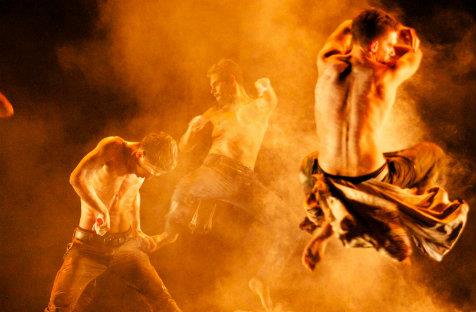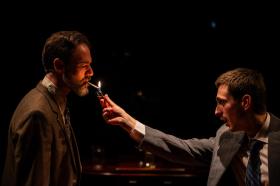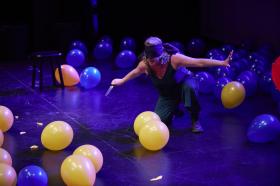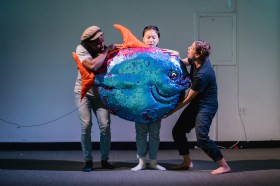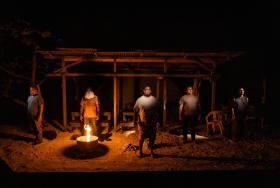Co-choreographed by Stephen Page and emerging choreographer Daniel Riley McKinley, who also dances in the production, Bangarra Dance Theatre’s Blak is an imperfect but powerful exploration of contemporary Indigenous identity and culture.
Presented in three parts, the work’s occasionally episodic structure is united by precise and powerful dancing and the vibrant fusion of music created collaboratively by Bangarra’s resident composer David Page and electro artist and producer Paul Mac. The latter’s musical influence, coupled with the presence of Stephen Page’s young son, actor turned dancer Hunter Page-Lochard, and McKinley’s choreography, results in a production full of promise and potential; though not yet the work of a brand new Bangarra, Blak is certainly redolent of a company that continues to grow and adapt to the challenges it will face in the future.
The first of the three works which makes up Blak is Scar, McKinley’s second choreographic work following Riley, from the 2010 double bill, of earth & sky. An exploration of contemporary rites of passage danced by the men of the company, Scar is a street-smart piece featuring displays of ritual aggression and violence and celebrating male strength and bonding. Dressed in hoodies and moving through smoky darkness and pools of light, the seven male dancers stamp their feet to the vibrant beat, raise arms and wrestle, grapple one another and drag their fellow dancers around the stage, successfully exploring the tension that exists between the individual and the group throughout. The lithe and slender presence of Hunter Page-Lochard clearly enunciates the work’s theme of coming of age, though an expressive solo danced by Waangenga Blanco, exploring scarification and self-harm, feels somewhat too literal (a fault more apparent in Blak’s second section, Yearning). When Scar begins the dancers are boys; it ends with them as men, adolescent hoodies discarded to reveal adult musculature, a strong and dynamic group supporting one another in the face of the many external challenges they have survived.
Danced by the women of the company, and choreographed by Page, Yearning is told in five distinct sections: Birth, Loss, Native Tongue, Broken and Unearthed. Dressed in blue shifts, Birth sees the women dance in a series of precise duos, swinging legs and extending arms as they spread across the stage from a central rectangle of blue cloth. Loss sees a grandmother sitting by the fire beneath a roof of corrugated iron, and evokes grief powerfully and simply through a series of lifts, four bodies supporting one. In Native Tongue, another loss – that of language – is evoked by the universal gesture of a hand over a mouth, and of once expressive hands tightly locked together.
Broken begins equally powerfully – the horror of domestic abuse is evoked voyeuristically; abject bodies clad in simple nightgowns cower in pools of yellow light – but as the piece progresses it becomes unnecessarily literal via fragments of aggressive and abusive dialogue which overwhelm and undermine its previously subtle power. Finally comes Unearthed, in which the seven women of the company, once more clad in the blue shifts we first saw them in, one by one step away from a waiting room bench to embrace their culture in a series of fluid solos, heads proudly raised.
Black-outs between each segment enhanced the episodic nature of Yearning, and diluted the energy of the more powerful sections; additionally, transitions between each scene felt drawn out, though doubtless these will tighten as the season continues.
The third and final part of Blak is Keepers, jointly choreographed by Page and McKinley in conjunction with Bangarra’s dancers, and performed before a rocky outcrop evoking a personal connection to the land. Featuring the 14 members of the company, both men and women, Keepers boasts a considered sense of special awareness and some slow, evocative movements, as well as a series of duos and trios in which lifts and interlocked feet play a significant part, though dramatically it felt a trifle inert, and again a little too loose, though it ends with a striking and memorable piece of stagecraft, beautifully enhanced by Matt Cox’s assured lighting design.
Blak is sure to tighten and improve as it continues to play; by the time it reaches Sydney, some of its faults will certainly have been fixed. Its occasionally over-literal exploration of social themes may be harder to address.
Rating: 3 ½ stars out of 5
Blak
Bangarra Dance Theatre
Choreographers: Stephen Page & Daniel Riley McKinley
Cultural Consultants: Djakapurra Munyarryun & Kathy Balngayngu Marika
Composers: David Page & Paul Mac
Set Designer: Jacob Nash
Costume Designer: Luke Ede
Lighting Design: Matt Cox
Arts Centre Melbourne
3 – 11 May
Additional performances:
IPAC Wollongong: 17 – 18 May
Sydney Opera House: 7 – 22 June
Canberra Theatre Centre: 11 – 13 July
QPAC Brisbane: 18 – 27 July
